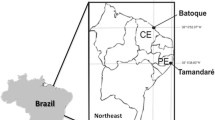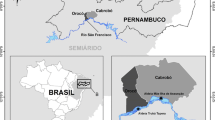Abstract
The fishing and hunting performed by inhabitants of the Extractive Reserve of the Upper Juruá, Acre, Brazil was studied, and an ecological analysis on the use of fish and game, including preferences, taboos and medicinal uses, and of fish abundance was made. Research was carried out at the Upper Juruá Extractive Reserve in three visits (1993 and 1994). A total of 143 individuals (101 families) living along the banks of the rivers Juruá, Tejo, Bagé, S. João and Breu were interviewed, and 115 species of fish with set gillnets were collected. Local economic activities included rubber-tapping and small-scale agriculture. Fishing was especially important in the dry season, when cast net and hook and line were used. Hunting and game consumption were intensive in the wet season. Some local rules may be useful as starting points for local management, such as the use of fish diversity through lake management, the use of water level seasonality, hunting periods or quotas, and food taboos. The integration of academic research with indigenous knowledge and demands is important to develop management plans which protect both biological and cultural diversity.
Similar content being viewed by others
References
ASAREAJ: 1993, Associação dos seringueiros e agricultores da Reserva Extrativista do AltoJuruá. Histórias do Alto Juruá, ASAREAJ, Centro Ecumênico de Documentação3Informação e Núcleo de História Indígena, Universidade de São Paulo, São Paulo.
Bakx, K.: 1990, ‘The shanty town, final stage of rural development? The case of Acre’, in D. Goodman and A. Hall (eds.), The Future of Amazônia, Destruction or Sustainable Development?, New York, St. Martin's Press.
Barthem, R.B. and Goulding, M.: 1997, The Catfish Connection: Ecology, Migration and Conservation of Amazon Predators, New York, Columbia University Press.
Bayley, P.B. and Petrere Jr., M.: 1989, ‘Amazon fisheries: assessment methods, current status and management options’, Can. Spec. Publ. Fish. Aquatic Sci. 106, 385-398.
Begossi, A.: 1992, ‘Food taboos at Búzios Island (Brazil): their significance and relation to folk medicine’, Journal of Ethnobiology 12, 117-139.
Begossi, A.: 1995, ‘Fishing spots and sea tenure: incipients forms of local management in Atlantic Forest coastal communities’, Human Ecology 23(3), 387-406.
Begossi, A.: 1998a, ‘Resilience and neotraditional populations: the caiçaras (Atlantic Forest) and caboclos (Amazon)’, in F. Berkes and C. Folke (eds.), Linking Social and Ecological Systems, Cambridge, Cambridge University Press, pp. 129-157.
Begossi, A.: 1998b, ‘Knowledge on the use of natural resources: contributions to local management’, in L. Hens, R.J. Borden, S. Suzuki and G. Caravello (eds.), Research in Human Ecology: An Interdisciplinary Overview, Proceedings of the Symposium organised at the VII International Congress of Ecology (INTECOL), Florença, Italia, Bruxelas, VUB Press, pp. 39-52.
Begossi, A.: 1999, ‘Scale of interactions of Brazilian populations (caiçaras and caboclos) with resources and institutions’, Human Ecology Review 6, 1-7.
Begossi, A. and Braga, F.M. de S.: 1992, ‘Food taboos and folk medicine among fishermen from the Tocantins River (Brazil)’, Amazoniana 12, 101-118.
Begossi, A. and Figueiredo, J.L.: 1995, ‘Ethnoichthyology of southern coastal fishermen: cases from Búzios Island and Sepetiba bay (Brazil)’, Bull. Mar. Sc. 56(2), 710-717.
Browder, J.O.: 1992, ‘The limits of extractivism. Tropical forest strategies beyond extractive reserves’, Bioscience, 42(3), 174-182.
Berkes, F. (ed.).: 1989, Common Property Resources: Ecology and Community-based Sustainable Development, London, Belhaven Press.
Berkes, F. and Farvar, M.T.: 1989, ‘Introduction and overview’, in F. Berkes (ed.), Common Property Resources, London, Belhaven Press, pp. 1-17.
Berkes, F., Folke, C. and Gadgil, M.: 1993, ‘Traditional ecological knowledge, biodiversity resilience, and sustainability’, Beijer Discussion Paper Series no. 31, The Beijer International Institute of Ecological Economics, Stockholm.
Castro, F. and Begossi, A.: 1995, ‘Ecology of fishing on the Grande River (Brazil): technology and territorial rights’, Fisheries Research 23, 361-373.
Cohen, J.E.: 1995, How many people can the earth support? New York, WW Norton and Co.
Colding and Folke, C.: 1997, ‘The relation between threatened species, their protection, and taboos’, Conservation Ecology 1, 1-19.
Constanza, R.: ‘Ecological economics: reintegrating the study of humans and nature’, Ecological Applications 6(4), 978-990.
Cunha, M.C., Brown Jr., K.S. and Almeida, M.W.B. (Coord.): 1992, ‘Can traditional forest-dwellers self-manage conservation areas? A probing experiment in the Juruá Extractive Reserve’, Acre, Brazil. Project supported by MacArthur Foundation grant #92-21848.
De Merona, B.: 1986/87, ‘Aspectos ecológicos da ictiofauna no baixo Tocantins’, Acta Amazônica 16/17, 109-124.
Fearnside, P.: 1986, Human Carrying Capacity in the Brazilian Rainforest, New York, Columbia University Press.
Fitzgerald, L.A.: 1994, ‘Tupinambis lizards and people: a sustainable use approach to conservation and development’, Conservation Biology 8, 12-16.
Gadgil, M., Berkes, F. and Folke, C.: 1993, ‘Indigenous knowledge for biodiversity conservation’, Ambio 22, 151-156.
Gentry, A.: 1994, ‘Como usar a biodiversidade sem deteriorar a floresta?’ Ciência Hoje 17, 54-57.
Giampietro, M.: 1997, ‘Linking technology, natural resources, and socioeconomic structure of human society: a theoretical model’, Advances in Human Ecology 6: 75-130.
Giampietro, M., Bukkens, S.G.F. and Pimentel, D.: 1993, ‘Labor productivity: a biophysical definition assessment’, Human Ecology 21, 229-260.
Goulding, M., Ferreira, E.J.G. and Carvalho, M.L.: 1988, Rio Negro — Rich Life in Poor Waters, SBP Academic Publishing.
Ibarra, M. and Stewart, J.D.: 1989, ‘Longitudinal zonation of sandy beach fishes in the Napo river basin, eastern Ecuador’, Copeia 2, 364-381.
IBGE — Instituto Brasileiro de Geografia e Estatístisca.: 1987, Anuário Estatístico do Brasil, 1986, Rio de Janeiro, p. 163.
Junk, W.J., Soares, M.G.M. and Carvalho, F.M.: 1983, ‘Distribution of fish species in a lake of the amazon river floodplain near Manaus (lago Camaleão), with special reference to extreme oxygen conditions’, Amazoniana 7(4), 397-431.
Lowe-McConnel, R.H.: 1987, Ecological Studies in Tropical Fish Communities, Cambridge, Cambridge University Press.
Malm, O., Pfeiffer, W.C., Souza, C.M.M. and Reuther, R.: 1990, ‘Mercury pollution due to gold mining in the Madeira river basin, Brazil’, Ambio 19(1), 11-15.
Mangel, M. et al.: 1996, ‘Principles for the conservation of wild living resources’, Ecological Applications 6, 338-362.
Marques, J.G.W.: 1995, Pescando pescadores. Nupaub, USP, São Paulo.
McCay, B. and Acheson, J.M. (eds.).: 1987, Questions of the Commons. Tucson, The University of Arizona Press.
MacGrath, D.G., Castro, F., Futemma, C., Amaral, B.D. and Calabria, J.: 1993, ‘Fisheries and the evolution of resource management on the lower Amazon floodpain’, Human Ecology, 21, 167-196.
Moran, E.: 1974, ‘The adaptive system of the Amazonian caboclo’, in C. Wagley (ed.), Man in the Amazon. Gainesville, University of Florida Press, pp. 136-159.
Moran, E.: 1990, A ecologia humana das populações da Amazônia, Editora Vozes, Petrópolis.
Nelson, J.G. and Serafin, R.: 1992, ‘Assessing biodiversity: a human ecological approach’, Ambio 21, 212-218.
Payne, A.I.: 1986, The Ecology of Tropical Lakes and Rivers, John Wiley & Sons, 248 p.
Peres, C.A.: 1994, ‘Indigenous reserves and nature conservation in Amazonian forests’, Conservation Biology 8(2), 586-588.
Posey, D.A.: 1983, ‘Indigenous knowledge and development: an ideological bridge to the future’, Ciência e Cultura 35, 877-894.
Posey, D.A., Frechione, J., Eddins, Da Silva, F., Myers, D., Case, D. and McBeath, P.: 1984, ‘Ethnoecology as applied anthropology in Amazonian development’, Human Organization 43, 95-107.
Poizat, G. and Baran, E.: 1997, ‘Fishermen's knowledge as background information in tropical fish ecology: a quantitative comparison with fish sampling results’, Env. Biol. Fish. 50, 435-449.
Rancy, C.M.D.: 1986, Raízes do Acre (1870–1912), Editôra Falangola, Secretaria do Estado de Educação e Cultura, Rio Branco, Acre.
Redford, K.H. and Stearman, A.M.: 1993, ‘Forest-dwelling native Amazonians and the conservation of biodiversity: interests in common or in collision?’ Conservation Biology 7, 248-255.
Salafasky, N., Dugelby, B.L. and Terborgh, J.W.: 1993, ‘Can extractive reserves save the rain forest? An ecological and socioeconomic comparison of nontimber forest product extraction systems in Petén, Guatemala and West Kalimantan, Indonesia’, Conservation Biology 7, 39-53.
Santos, G.M.: 1986/87, ‘Composição do pescado e situacão da pesca no Estado de Rondônia’, Acta Amazônica, 16/17(Suppl.), 43-84.
Santos, G.M., Jegu, M. and De Merona, B.: 1984, Catálogo de Peixes Comerciais do Baixo Rio Tocantins, Eletronorte/CNPq/INPA.
Schwartzman, S.: 1989, ‘Extractive Reserves: the rubber tapper's strategy for sustainable use of the Amazon Rainforest’, in J. Browder (ed.), Fragile Lands of Latin America: Strategies for Sustainable Development, Westview Press, pp. 150-165.
Setz, E.Z.F., Almeida, M. and Melo, A.B.: 1996, ‘Diário de caça de uma colocação de seringueiros no Alto Juruá: uma análise quantitativa’, in I Simpósio de Etnobiologia e Etnoecologia, Abstracts, Feira de Santana, March 3–8, 1996, p. 15.
Siebert, S.F.: 1993, ‘Rattan and Extractive Reserves’, Conservation Biology 7, 749-750.
Silvano, R.A.M.: 1997, Ecologia de três comunidades de pescadores no rio Piracicaba (SP). M.S. thesis, UNICAMP, Campinas, Brazil. 147 p.
Silvano, R.A.M., Amaral, B.D. and Oyakawa, O.T.: 1998, ‘Spacial and temporal patterns of diversity, fishery productivity and distribution of fish communities in the Upper Juruá Extractive Reserve (Brazilian Amazon)’, American Society of Ichthyologists and Herpetologists 78th Annual Meeting, July 16–22, 1998, Guelph, Ontario, Canada.
Smith, N.J.: 1976, ‘Utilization of game along Brazil's transamazon highway’, Acta Amazônica, 6(4), 455-466.
Author information
Authors and Affiliations
Corresponding author
Rights and permissions
About this article
Cite this article
Begossi, A., Silvano, R., do Amaral, B. et al. Uses of Fish and Game by Inhabitants of an Extractive Reserve (Upper Juruá, Acre, Brazil). Environment, Development and Sustainability 1, 73–93 (1999). https://doi.org/10.1023/A:1010075315060
Issue Date:
DOI: https://doi.org/10.1023/A:1010075315060




